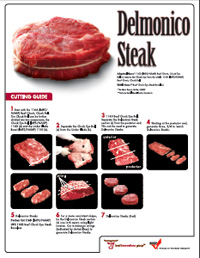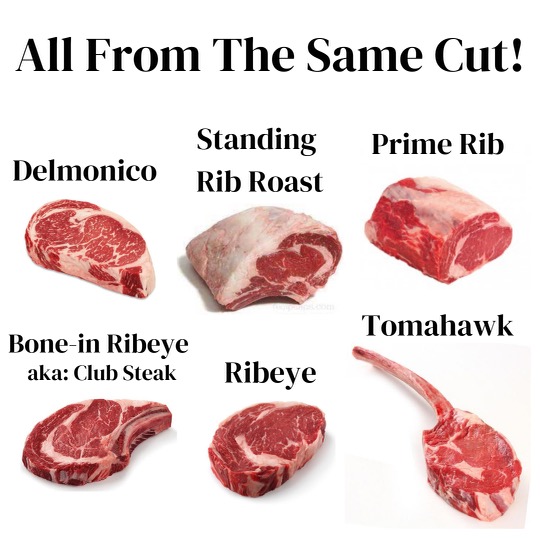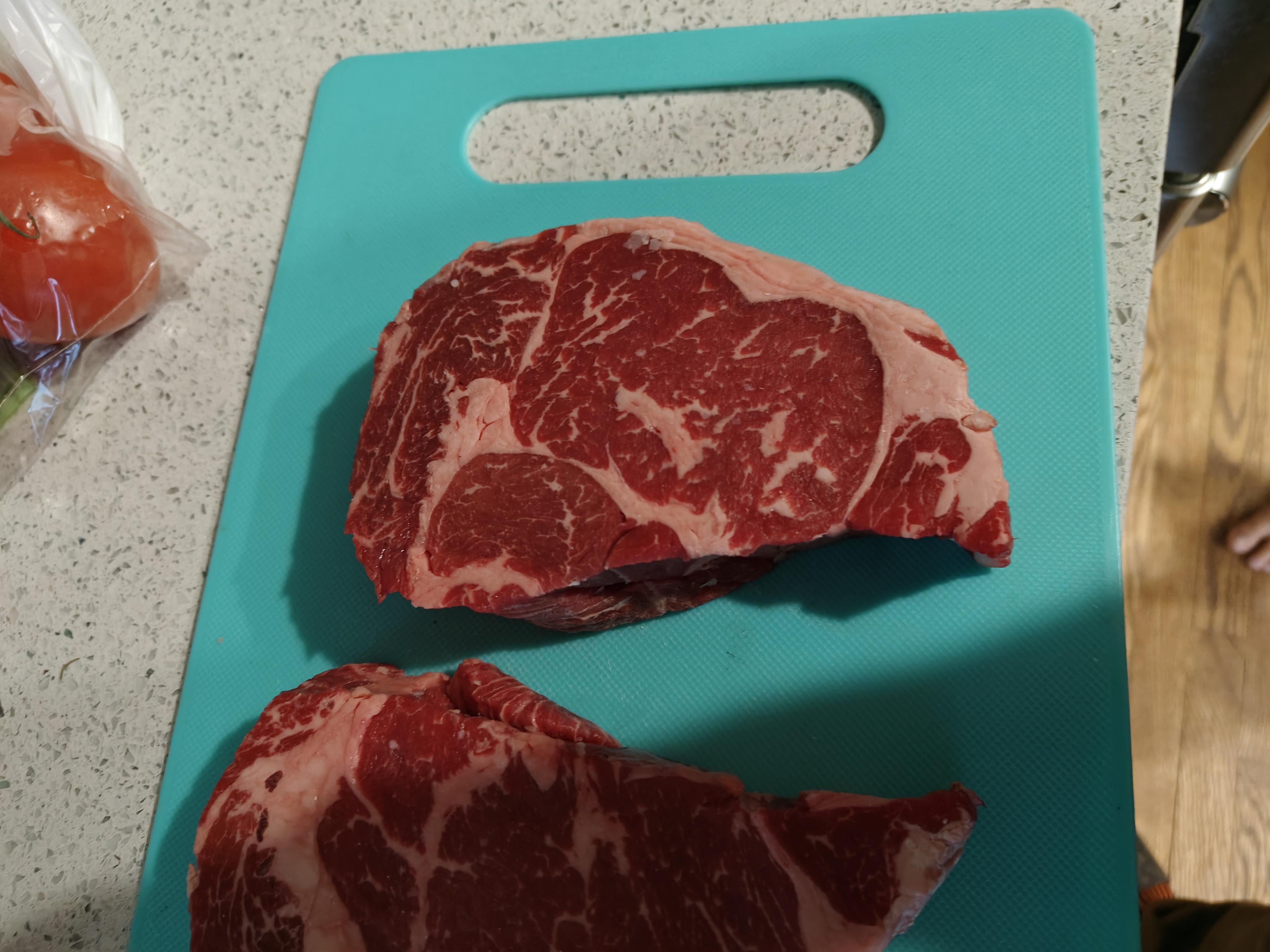What Is A Delmonico Steak?

A Delmonico steak is a cut of beef that is known for its tenderness and rich flavor. It is typically cut from the rib section of the cow, similar to a ribeye steak. The Delmonico steak is often thicker than a ribeye, giving it a juicy and succulent texture. It is commonly prepared by grilling or pan-searing to enhance its natural flavors. The Delmonico steak is highly regarded for its marbling, which adds to its overall taste and juiciness. Whether enjoyed on its own or paired with a delicious sauce, the Delmonico steak is a popular choice for steak lovers.
What Makes Delmonico Steak Unique?
Delmonico Steak is known for its unique characteristics that set it apart from other cuts of steak. One of the main factors that make Delmonico Steak stand out is its tenderness. It is incredibly soft and succulent, making it a popular choice among steak enthusiasts. Additionally, the richness of flavor in Delmonico Steak is exceptional, thanks to its marbling and fat content. The unique combination of tenderness and flavor makes Delmonico Steak a gourmet delight that is highly sought after by steak connoisseurs.
Different Cuts Of Delmonico Steak
Delmonico Steak is not limited to a specific cut; rather, it refers to the method of preparation and cooking. However, there are a few popular cuts that are commonly used for Delmonico Steak. These include the boneless ribeye, bone-in ribeye, and the bone-in New York strip. Each cut offers a unique texture and flavor profile, but they all share the tenderness and richness that are characteristic of Delmonico Steak. Whether you prefer a boneless option or enjoy the added flavor from the bone-in cuts, Delmonico Steak can be enjoyed in various ways.
The Ribeye Steak

The Ribeye steak is a highly sought after cut known for its exceptional tenderness, marbling, and rich flavor. It is often hailed as the prime choice for steak lovers due to its superior taste and texture. Whether cooked with the bone-in or boneless, the Ribeye steak delivers a melt-in-your-mouth experience that is hard to beat. With its perfect balance of fat and meat, the Ribeye offers a juicy and flavorful bite that is sure to satisfy even the most discerning palate. It’s no wonder that Ribeye steak is one of the top sellers in the steak industry.
Understanding The Ribeye Cut
The Ribeye cut is a highly sought after steak known for its exceptional tenderness, marbling, and rich flavor. It is derived from the rib section of the cow, specifically from the sixth to the twelfth ribs. This cut is also sometimes referred to as a “Delmonico” steak in certain regions. The Ribeye is favored for its abundant marbling throughout the meat, which contributes to its juiciness and flavor. Whether cooked bone-in or boneless, the Ribeye offers a melt-in-your-mouth experience that is hard to beat.
Ribeye: Bone-in Vs Boneless
When it comes to Ribeye steaks, you have the option of choosing between bone-in and boneless cuts. The main difference between the two lies in the texture and flavor they offer.
Bone-in Ribeye steaks are known for their added juiciness and tenderness. The bone helps to distribute heat more evenly during cooking, resulting in a moist and flavorful steak. Additionally, the bone can provide an extra layer of flavor to the meat.
On the other hand, boneless Ribeye steaks offer convenience and ease of eating. They are easier to handle and require less effort when slicing.
Ultimately, the choice between bone-in and boneless Ribeye steaks depends on personal preference and the cooking method you plan to use.
Flavor And Texture

Delmonico steak offers a robust, beefy flavor with a heartier and leaner texture. It may not match the tenderness of ribeye, but the flavor profile can be quite satisfying when prepared thoughtfully. On the other hand, ribeye steak is known for its exceptional tenderness, marbling, and rich flavor. The high fat content from marbling contributes to its luxurious mouthfeel and juiciness. The combination of tenderness and flavor makes ribeye a favorite among steak enthusiasts. Ultimately, the choice between Delmonico and ribeye depends on personal preference and desired texture and flavor profile.
Delmonico Steak: Flavor Profile And Tenderness
Delmonico steak offers a robust, beefy flavor with a heartier and leaner texture. It may not match the tenderness of ribeye, but the flavor profile can be quite satisfying when prepared thoughtfully. The steak is known for its rich, meaty and slightly chewy texture. The marbling is not as prominent as in ribeye, but it still adds juiciness and flavor to the steak. The leaner nature of the cut lends itself well to marinades and seasoning, allowing the flavors to penetrate and enhance the overall taste.
Ribeye Steak: Flavor Profile And Tenderness
The Ribeye steak is known for its exceptional flavor profile and tenderness. It offers a rich and robust beef flavor that is deeply satisfying. The meat is tender and juicy, thanks to its generous marbling. The marbling melts during cooking, infusing the steak with flavor and keeping it moist. This combination of tenderness and flavor makes the Ribeye steak a favorite among steak enthusiasts. Whether grilled, pan-seared, or broiled, the Ribeye steak consistently delivers a melt-in-your-mouth experience that is hard to resist.
Cooking Techniques

When it comes to cooking techniques, both Delmonico and Ribeye steaks can be prepared in various ways to bring out their unique flavors and textures. Here are some recommended cooking methods for each:
Best cooking methods for Delmonico Steak:
- Grilling: Delmonico steak can be grilled to perfection, enhancing its natural flavors and creating a delicious charred exterior.
- Broiling: Broiling is another great option for Delmonico steak, as it allows for high heat cooking and caramelization of the meat’s surface.
- Braising: Slow-cooking the Delmonico steak in a flavorful liquid can help tenderize the meat and develop rich flavors.
Best cooking methods for Ribeye Steak:
- Grilling: Ribeye steak is famous for its marbling, which melts during grilling, creating a juicy and flavorful steak.
- Pan-searing: Searing the Ribeye steak on a hot skillet can create a crispy crust while maintaining its tenderness.
- Oven-roasting: By cooking the Ribeye steak in the oven, you can achieve an even cook throughout the meat and enhance its natural flavors.
Ultimately, the recommended cooking technique for both steaks depends on personal preference and desired doneness. Experimenting with different cooking methods can help you discover your favorite way to enjoy these delicious cuts of beef.
Best Cooking Methods For Delmonico Steak
Delmonico steak is a versatile cut that can be prepared using various cooking methods to enhance its unique flavors and textures. The best cooking methods for Delmonico steak include grilling, broiling, and braising.
Grilling the Delmonico steak gives it a delicious charred exterior while preserving its natural flavors. Broiling is another excellent option, allowing for high heat cooking and caramelization of the meat’s surface. Alternatively, slow-cooking the Delmonico steak through braising can tenderize the meat and develop rich flavors. Each method brings out different qualities of the steak, so it’s worth trying them all to find your preferred cooking technique for Delmonico steak.
Best Cooking Methods For Ribeye Steak
When it comes to cooking Ribeye steak, the best methods are grilling and pan-searing. Grilling allows for the steak to develop a flavorful crust while retaining its natural juices. For a medium-rare Ribeye, grill it at high heat for about 4-5 minutes per side. Pan-searing is another excellent option, providing a delicious caramelization to the steak’s surface. Heat a cast-iron skillet with some oil and sear the Ribeye for about 3-4 minutes per side. Regardless of the cooking method, it’s crucial to let the Ribeye rest for a few minutes before slicing to ensure optimal tenderness.
Note: Be sure to reference the source in this section.
Which One To Choose?

When it comes to choosing between Delmonico and Ribeye steak, it ultimately comes down to personal preference. Both cuts offer unique flavors and tenderness. If you prefer a leaner cut with a milder flavor, the Delmonico may be the better choice for you. However, if you crave a well-marbled, juicy steak with intense beefy flavor, the Ribeye is the way to go. Consider factors such as your taste preferences, cooking methods, and budget. Regardless of your choice, both Delmonico and Ribeye steaks are sure to satisfy any steak lover’s cravings.
Comparing Delmonico And Ribeye: Flavor, Tenderness, And Popularity
Delmonico and Ribeye steaks offer distinct flavors and levels of tenderness. The Ribeye steak is known for its rich, beefy flavor and exceptional tenderness due to its marbling. With its higher fat content, it delivers a melt-in-your-mouth experience. On the other hand, Delmonico steak offers a robust, hearty flavor and is leaner compared to the Ribeye. While it may not be as tender, it still provides a satisfying dining experience. In terms of popularity, the Ribeye steak typically takes the lead, but Delmonico steak is gaining recognition for its unique taste and affordability. Ultimately, it comes down to personal preference when choosing between these two delicious options.
Factors To Consider When Choosing Between Delmonico And Ribeye
When deciding between Delmonico and Ribeye steaks, there are a few factors to consider. Firstly, if you prefer a steak with a richer flavor and exceptional tenderness, the Ribeye is the clear winner. However, if you’re looking for a more affordable option that still delivers a robust beefy flavor, the Delmonico steak is a great choice. Additionally, the cooking method should be considered. While both steaks can be cooked using various techniques, the Ribeye’s higher fat content makes it more forgiving and less likely to dry out. Ultimately, it comes down to personal preference and budget.
Conclusion

In conclusion, when it comes to choosing between Delmonico and Ribeye steaks, there is no clear winner. It ultimately depends on personal preference and budget constraints. The Ribeye steak offers a richer flavor and exceptional tenderness, while the Delmonico steak provides a more affordable option with a robust beefy profile. Both cuts can be cooked using various methods, but the Ribeye’s higher fat content makes it more forgiving and less likely to dry out. Consider your flavor preferences and cooking techniques to make the best choice for your steak experience.
Personal Preference And Recommendations
When it comes to personal preference, choosing between Delmonico and Ribeye steaks ultimately boils down to individual taste and budget constraints. For those who prioritize tenderness and marbling, the Ribeye steak is the superior choice. Its rich flavor and exceptional texture make it a favorite among steak enthusiasts. However, if budget considerations are a priority or if you prefer a robust beefy profile, the Delmonico steak is a great option. Its affordability and bold flavor make it a delicious and budget-friendly alternative. Ultimately, it’s important to consider your own preferences and make a choice based on what appeals to you the most.
Final Thoughts On Delmonico Vs Ribeye
When it comes to choosing between Delmonico and Ribeye steaks, it ultimately comes down to personal preference and budget. While the Ribeye steak is known for its exceptional tenderness and marbling, the Delmonico steak offers a more budget-friendly option without sacrificing flavor. Both steaks have their unique qualities and can be cooked to perfection using various cooking techniques. Ultimately, it is important to consider your own taste preferences and budget constraints when deciding between these two delicious cuts of beef. Whichever steak you choose, you are sure to enjoy a delicious and satisfying meal.
Frequently Asked Questions about Delmonico versus Ribeye
1. What is the difference between Delmonico and Ribeye?
Delmonico and Ribeye are two popular cuts of beef, but they have some notable differences. The primary difference lies in the origin of the names and the way they are usually prepared. Delmonico steak is cut from the rib section of a cow, while Ribeye, as the name suggests, is specifically cut from the rib area. Delmonico is often prepared bone-in, while Ribeye can be found both bone-in and boneless.
2. Which cut is more tender?
Both Delmonico and Ribeye are known for their tenderness and rich flavor. However, Ribeye is typically considered to be slightly more tender due to the marbling of fat within the muscle fibers. This fat content enhances the tenderness and juiciness, making Ribeye a popular choice for steak lovers.
3. Are Delmonico and Ribeye the same in terms of taste?
In terms of taste, Delmonico and Ribeye offer a similar beefy flavor due to their location on the animal and the marbling of fat within the meat. However, the difference in their preparation methods might affect the overall taste experience. Delmonico steak is often associated with more luxurious and indulgent preparations, such as being rubbed with herbs or butter, while Ribeye is sometimes enjoyed as a standalone cut with minimal seasoning to highlight its natural flavors.
4. Can I cook Delmonico and Ribeye using the same method?
Both Delmonico and Ribeye can be cooked using similar methods, such as grilling, pan-searing, or broiling. However, due to the Bone-in nature of some Delmonico steaks, they may require a longer cooking time to ensure even heat distribution. It is important to monitor the temperature and cooking time carefully to achieve the desired level of doneness for each cut.
5. Which cut is more expensive?
Delmonico and Ribeye can vary in price depending on various factors such as the quality of the meat, the supplier, and the location. Generally, Delmonico steak is considered slightly more expensive due to its association with finer dining establishments and the perception of it being a more premium cut. However, the prices of both cuts can fluctuate, so it’s always good to check with your local butcher or meat supplier for the most up-to-date pricing information.
In summary, Delmonico and Ribeye are both delicious and popular cuts of beef, loved by steak enthusiasts. While Delmonico is cut from the rib section and often prepared with the bone-in, Ribeye can be found both bone-in and boneless, with a slightly more tender texture. The taste is similar, but the preparation methods and cooking times may vary. Ultimately, the choice between these cuts depends on personal preference, desired cooking method, and budget.

Everyone has had a recipe that looked great on paper but ended up burning once you got into the kitchen. Obviously, a recipe isn’t just about what ingredients go into it. Knowing how you prepare a dish has a strong impact on how it finally tastes.